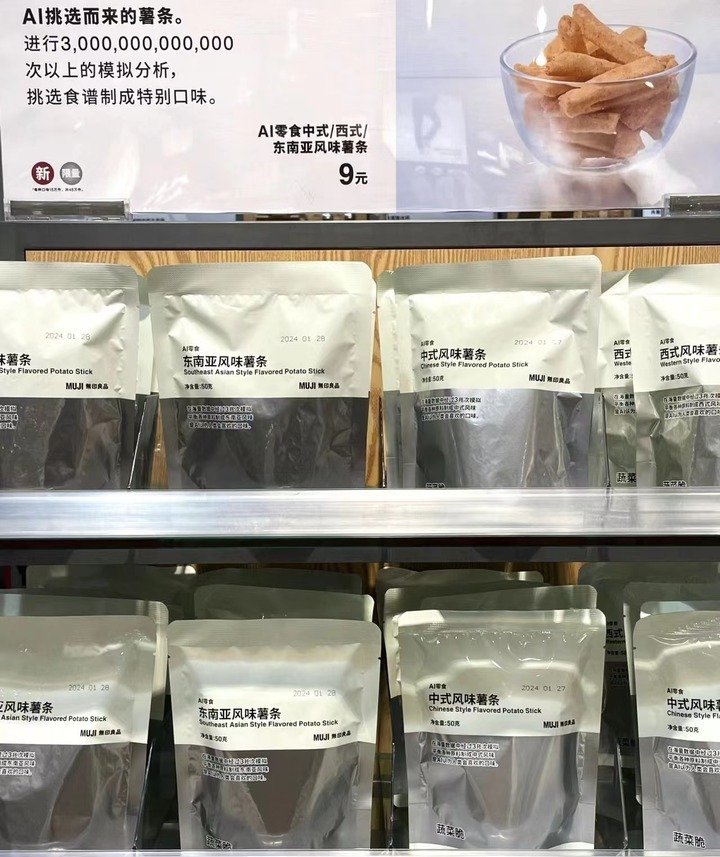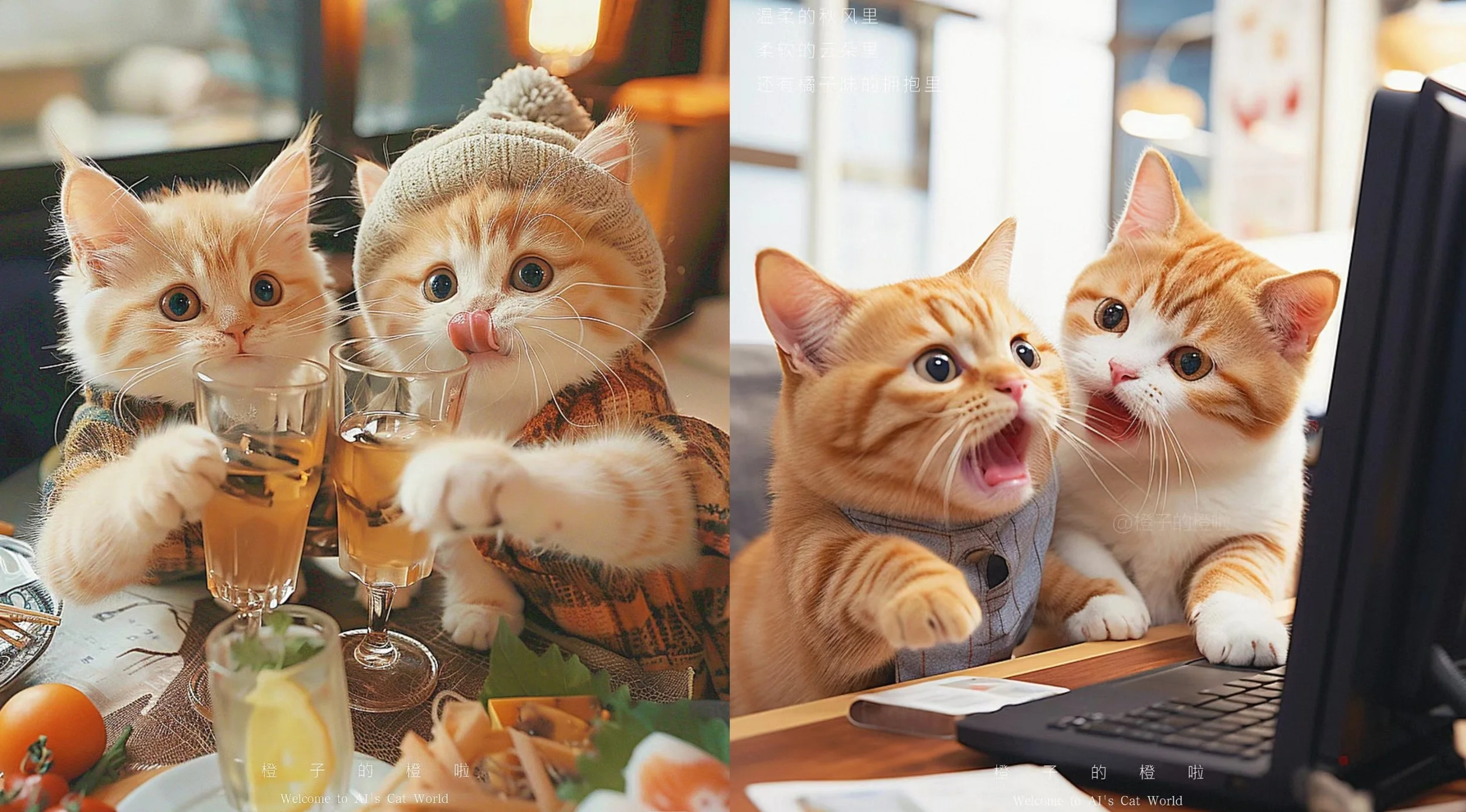Does AI food really understand Chinese consumers better?
In February this year, MUJI's flagship store in Beijing introduced a snack called "AI Fries" in its snack section. This product comes in three flavours: "Southeast Asian," "Chinese," and "Western," each priced at 9 RMB ($1.20) for 50 grams. The packaging prominently states, "developed through 3 trillion simulations to balance various ingredients, this is the flavour AI believes humans will enjoy."

MUJI's AI Fries packaging maintains the brand's signature minimalist and elegant style. The image is from Shobserver.
Although there is no information yet on the sales performance of this product, consumer feedback on social media suggests it may not be very successful. On platforms like Weibo, RED, and Bilibili, most people were initially surprised and associated it with ChatGPT. However, after trying the product, the general response has been quite negative, with some humorously suggesting, "AI-created food should be eaten by AI itself."

While many people find this snack intriguing, reviews on social media are generally negative. Images are from RED, Weibo and Bilibili.
Many people have criticized the so-called "Western" and "Chinese" flavours of these fries as relying on regional stereotypes. For example, with the "Chinese" flavour, few consumers reported enjoying the taste. Instead, many said it reminded them of medicinal herbs, chicken soup, braised meat, or even Huoxiang Zhengqi Liquid (a type of traditional Chinese medicine). It seems as though the flavours were a hodgepodge of stereotypical Chinese elements, lacking in coherence and depth.
In fact, many in the Chinese food & beverage industry is increasingly leveraging AI technology due to its advantages in cost and production efficiency. Since early 2023, numerous examples have demonstrated the wide application of AI technology. For instance, Luckin Coffee's orange latte product poster was designed by AI, Yili Group has started using AI for designing milk packaging, and Coca-Cola's limited-edition “Y 3000” product claims to use AI for everything from naming and flavour selection to packaging design and marketing.

Images show some AI-designed beverage products that have appeared in the Chinese market since 2023. Images are from Sohu.com
However, most successful AI applications so far have been outside of flavour development or have served a supportive role within it. In China, the booming RTE meal industry has heightened consumer demand for fresh and healthy food. Busy schedules and fast-paced lifestyles make people increasingly inclined to enjoy dishes with wok aroma in their downtime. AI-designed foods often come across as a fleeting technological novelty, offering a brief sense of freshness but struggling to evoke human touch.

Images are from the popular Chef Fei Chili Stir-Fry restaurant in China, which promotes itself with the slogan "Stir-Fried to Perfection." Images are from RED.
As Alibaba founder Jack Ma once said, "AI has immense potential, but humans have hearts with warmth." This mirrors the cautionary "high-tech, low-life" scenes from many early 21st-century cyberpunk films. Just as countless classic and timeless brands in history symbolize more than just a single product for consumers—representing a consensus that has stood the test of time—AI technology struggles to offer that same level of pure, authentic, and unique perception.
Despite foreign brands generally being perceived as safer in China, they often squander this advantage by failing to localise and understand the ecosystem and cultural nuances
A concise yet holistic summary of March 2025’s key marketing developments in China, highlighting valuable insights and their implications for brands.
Instead of chasing scale through aggressive franchising or racing to the bottom with price wars, Honeymoon and Ah-Ma Handmade are playing the long game: building brands rooted in culture, craftsmanship, and emotional connection
With local competitors mastering manufacturing efficiency and aggressive pricing, foreign brands have wrestled with the challenge to remain relevant without succumbing to the price war. Heytea provides some valuable lessons for maintaining premium positioning
Mixue is now the largest fast food chain in the world by stores. It hasn’t got there by following the Western outsourcing model, rather building on a structure that takes advantage of China’s unique infrastructure
Mixue has surpassed Starbucks and McDonald's to become the world's largest fast food chain. As the details illustrate, it wasn't by accident. The company's record-breaking IPO looks set to fund its next round of expansion
A concise yet holistic summary of February 2025’s key marketing developments in China, highlighting valuable insights and their implications for brands.
China’s technological acceleration has come as a shock to many, particularly DeepSeek, however the country’s centrally planned economy, long-term planning and wealth of resources means it is increasingly well-positioned to make breakthroughs. All the more so when cornered by economic pressure such as semiconductor restrictions which contributed to the rise of DeepSeek.
Xianyu has evolved from a second-hand marketplace into a hub for youth culture, side hustles, and digital innovation, offering valuable insights for foreign brands in China
Blind boxes are redefining value, experience, and ethics in consumption. The intersection of affordability, gamification, and sustainability is a powerful formula that brands can learn from and adapt.
Jack Ma launched New Retail with a roar in 2016 starting a scramble for the New Retail crown on both sides of the Pacific. The buzzword has since fizzled out and Alibaba has divested in much of its bricks & mortar retail properties, but the need to rethink retail is more important than ever. Here's why...
Despite being winter, Naimi's novel fried chicken-looking ice creams are flying out of the chiller. Their success provides many valuable lessons for brands selling in China
Why DeepSeek’s new app may alter the path of geopolitics and economies globally, and play a big part in marketing in China
Photos of supermarkets like Sam’s Club being squeezed with throngs of shoppers in the CNY period
A concise yet holistic summary of January 2025’s key marketing developments in China, highlighting valuable insights and their implications for brands.
Hyper-local regional specialities are becoming increasingly popular in China based on their grassroots authenticity and uniqueness, presenting valuable lessons for foreign brands
AI has become an integrated tool for marketing in China 2025, making marketing easier at a surface level, but harder than it has ever been before. How do brands utilise AI to stand out?
A concise summary of last month's key marketing developments in China, highlighting valuable insights and their implications for brands.
China's coffee revolution is brewing. From Cotti Coffee's rapid rise to shifting cultural trends, discover why coffee could become China's next daily staple.
We’ve seen a number of companies in China back away from selling branded products to focus on selling commodities, parts or white labels. Based on the nature of the Chinese market, what is the best approach?
From adapting flavours to creating viral moments, Oreo has continually evolved to meet the changing tastes and lifestyles of Chinese consumers, transforming the foreign brand into a household favourite.
Chinese sanitary pad brands face backlash over misleading lengths and pH standards akin to tablecloths, sparking consumer boycotts and calls for reform. The willingness to talk about once-taboo products shows a new era of consumer pushback and could provide advantages for cross border products
Blind boxes are trending in China. Supermarket blind boxes were one of the big sellers at this month's 11-11 shopping festival, with everything from beer to baby diapers mystery boxes popular. Here’s why it makes so much sense.
After spreading over social media, China’s youth have demonstrated their need for community and adventure en masse causing a stir on their 50km group ride
As Chinese consumers increasingly prioritize health and wellness, fresh milk and fruit tea brands are stepping up, with HEYTEA standing out prominently. This article explores HEYTEA's health-focused marketing strategies and provides insights for brands looking to cultivate health-oriented perceptions.
China's seniors are one of the most anticipated demographics, yet one of the least tapped by foreign brands. Preferences, behaviour and influences are all changing, helping to make them more accessible for foreign brands
Following the robotic dogs, CASIO's latest innovation, the AI pet Moflin, is broadening horizons of what these pets can be. Beyond AI pet healthcare and smart supplies, AI is spawning exciting product placement opportunities related to pets.
Although summer has come to an end in China, the enthusiasm for ice cups remains strong. Coffee ice cubes and fruit-flavoured ice ball cups have further encouraged people to explore DIY mixers and enhance their beverage experiences.
As new generations redefine what weddings look like, brands are seizing the moment to connect with young couples seeking authenticity and personalization.
China's consumer landscape is increasingly divergent. Lower-tier cities are rebounding faster and showing greater resilience than first- and second-tier cities. While large catering businesses struggle, smaller restaurants thrive. How can brands understand these diverging trends and their implications? Read on to find out more.






























